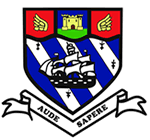
Queen Elizabeth's School, Barnet is a boys' grammar school in Barnet, northern Greater London, which was founded in 1573 by Robert Dudley, 1st Earl of Leicester, and others, in the name of Queen Elizabeth I.

A grammar school is one of several different types of school in the history of education in the United Kingdom and other English-speaking countries, originally a school teaching Latin, but more recently an academically oriented secondary school.

Dr Challoner's Grammar School is a selective grammar school for boys, with a co-educational Sixth Form, in Amersham, Buckinghamshire, England. It was given academy status in January 2011.

Watford is a town and borough in Hertfordshire, England, 15 mi (24 km) north-west of Central London, on the banks of the River Colne.

Aylesbury Grammar School is an 11–18 boys grammar school in Aylesbury, in the English county of Buckinghamshire, which educates approximately 1300 boys.

The Belvedere Academy is an all-ability state-funded girls’ Academy secondary- formerly independent- school in Liverpool, England. Its predecessor, The Belvedere School, was founded in 1880 as Liverpool High School. It is non-denominational, non-feepaying, and one of the 29 schools of the Girls' Day School Trust. In September 2007 it became an Academy, as one of the first two private schools in the UK to do so.
Ripon Grammar School is a co-educational, boarding and day, selective grammar school in Ripon, North Yorkshire, England. It has been named top-performing state school in the north for ten years running by The Sunday Times. It is one of the best-performing schools in the North of England; in 2011, 91% of pupils gained the equivalent of 5 or more GCSEs at grade C or above, including English and maths; the figure has been over 84% consistently since at least 2006. As a state school, it does not charge fees for pupils to attend, but they must pass an entrance test at 11+ or 13+. There is no selection test for entry into sixth form as pupils are admitted on the basis of their GCSE grades.

The Stephen Perse Foundation is a family of private schools in Cambridge and Saffron Walden for students aged 1 to 18.
The grammar schools debate is a debate about the advantages and disadvantages of the existence of grammar schools in the United Kingdom. Grammar schools are state schools which select their pupils on the basis of academic ability, with pupils sitting an exam in the last year of primary school to determine whether or not they gain a place. The debate on selective education has been widened by measures which allow a proportion of students to be chosen based on their "aptitude" for a particular subject.
Lincolnshire is one of the few counties within the UK that still uses the eleven-plus to decide who may attend grammar school, in common with Buckinghamshire and Kent.

Elizabeth Fuller (1644–1709) founded a Free School for boys and girls in Watford, Hertfordshire, England.

Watford Grammar School for Boys is an 11–18 boys partially selective academy in Watford in Hertfordshire, England. The school and its sister school, Watford Grammar School for Girls, descend from a Free School founded as a charity school for boys and girls by Elizabeth Fuller in 1704.
Parmiter's School is a co-educational state comprehensive school with academy status in Garston, Hertfordshire, close to the outskirts of North West London, England with a long history. Although the school admits pupils of all abilities it is partially selective. It is currently the most oversubscribed school in Hertfordshire, and has often been recognised by the Department for Education and Skills (DfES) for being one of the highest-performing schools in the country by value added and score as a mixed-ability school.

Parkstone Grammar School is a selective, all-girls academy school in Poole specializing in science and languages, on the southern coast of England.

The King's School is an 11–18 boys grammar school with academy status, in the market town of Grantham, Lincolnshire, England. The school's history can be traced to 1329, and was re-endowed by Richard Foxe in 1528. Located on Brook Street, the school's site has expanded over the course of its history, with some school buildings dating back to 1497.
Westcliff High School for Girls, also known by its initialism WHSG, is a selective grammar school and academy for girls in Southend-on-Sea, Essex and surrounding areas. It teaches students from the age of 11 through to 18 years old, and admission to the school is dependent upon their performance in selective 11+ tests set by the Consortium of Selective Schools in Essex (CSSE).
Queens' School, near Watford, Hertfordshire, is a partially selective secondary school and sixth form with academy status. It currently is a specialist science and sports college.

Leeds Grammar School was an independent school founded 1552 in Leeds, West Yorkshire, England. Originally a male-only school, in August 2005 it merged with Leeds Girls' High School to form The Grammar School at Leeds. The two schools physically united in September 2008.
This article provides brief details of primary schools in the borough of Watford in Hertfordshire, England, United Kingdom. Some Watford children attend schools in the neighbouring boroughs of Three Rivers and Hertsmere.

Torquay Boys' Grammar School is an 11–18 selective boys grammar school in Torquay, Devon, England. As of May 2023, it had 1,087 students. The school was founded in 1904. It is situated in Shiphay, south of Torbay Hospital, not far from the A3022 and Torre railway station as well as being directly next to Torquay Girls Grammar School.














